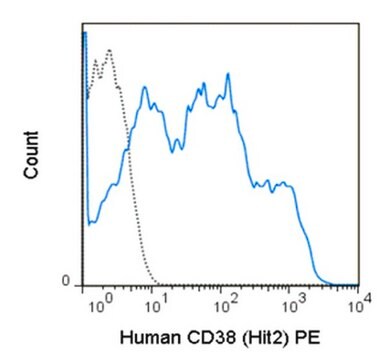MABT875
Anti-phospho-cytokeratin-18 (K18) (Ser33) Antibody, clone IB4
clone IB4, from mouse
Sinonimo/i:
Keratin type I cytoskeletal 18, Cell proliferation-inducing gene 46 protein, CK-18, Keratin-18, K18
About This Item
Prodotti consigliati
Origine biologica
mouse
Forma dell’anticorpo
purified immunoglobulin
Tipo di anticorpo
primary antibodies
Clone
IB4, monoclonal
Reattività contro le specie
human
Confezionamento
antibody small pack of 25 μg
tecniche
immunocytochemistry: suitable
immunofluorescence: suitable
immunoprecipitation (IP): suitable
western blot: suitable
Isotipo
IgG1κ
N° accesso NCBI
N° accesso UniProt
modifica post-traduzionali bersaglio
phosphorylation (pSer33)
Informazioni sul gene
human ... KRT18(3875)
Descrizione generale
Specificità
Immunogeno
Applicazioni
Immunoprecipitation Analysis: A representative lot immunoprecipitated phospho-cytokeratin-18 (K18) (Ser33) in immunoprecipitation applications (Ku, N.O., et. al. (1998). EMBO J. 17(7):1892-906).
Immunofluorescence Analysis: A representative lot detected phospho-cytokeratin-18 (K18) (Ser33) in Immunofluorescence applications (Ku, N.O., et. al. (1998). EMBO J. 17(7):1892-906).
Western Blotting Analysis: A representative lot detected phospho-cytokeratin-18 (K18) (Ser33) in Western Blotting applications (Yoon, K.H., et. al. (2001). J Cell Biol. 153(3):503-16).
Cell Structure
Qualità
Western Blotting Analysis: 2 µg/mL of this antibody detected phospho-cytokeratin-18 (K18) (Ser33) in lysate from HeLa cells treated with Calyculin A/Okadaic Acid.
Descrizione del bersaglio
Stato fisico
Stoccaggio e stabilità
Altre note
Esclusione di responsabilità
Non trovi il prodotto giusto?
Prova il nostro Motore di ricerca dei prodotti.
Certificati d'analisi (COA)
Cerca il Certificati d'analisi (COA) digitando il numero di lotto/batch corrispondente. I numeri di lotto o di batch sono stampati sull'etichetta dei prodotti dopo la parola ‘Lotto’ o ‘Batch’.
Possiedi già questo prodotto?
I documenti relativi ai prodotti acquistati recentemente sono disponibili nell’Archivio dei documenti.
Il team dei nostri ricercatori vanta grande esperienza in tutte le aree della ricerca quali Life Science, scienza dei materiali, sintesi chimica, cromatografia, discipline analitiche, ecc..
Contatta l'Assistenza Tecnica.








